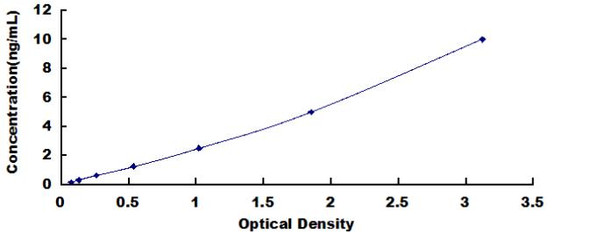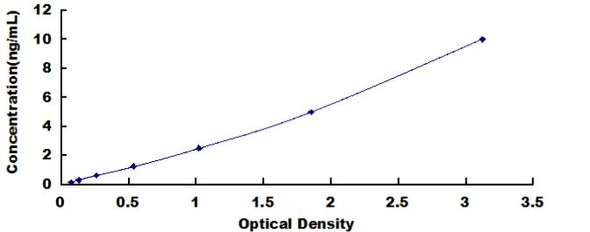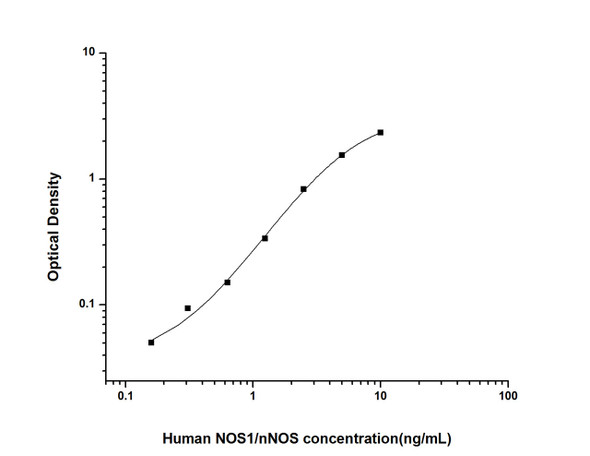Rat Nitric oxide synthase, brain (Nos1) ELISA Kit (RTEB0375)
- SKU:
- RTEB0375
- Product Type:
- ELISA Kit
- Size:
- 96 Assays
- Uniprot:
- P29476
- Range:
- 0.156-10 ng/mL
- ELISA Type:
- Sandwich
- Synonyms:
- NOS1, nNOS, bNOS, brain, Constitutive NOS, IHPS1, Neuronal NOS, nitric oxide synthase 1, neuronal, N-NOS, NOS type I, NOS, Peptidyl-cysteine S-nitrosylase NOS1
- Reactivity:
- Rat
Description
Rat Nitric oxide synthase, brain (Nos1) ELISA Kit
The Rat Nitric Oxide Synthase Brain (NOS1) ELISA Kit is specifically designed for the accurate measurement of NOS1 levels in rat brain tissue samples. This kit offers high sensitivity and specificity, ensuring precise and reproducible results for a variety of research applications.NOS1 is an important enzyme involved in the production of nitric oxide, a key signaling molecule in the brain that plays a crucial role in various physiological processes such as neurotransmission, neuroprotection, and neuroinflammation.
Abnormalities in NOS1 expression have been linked to neurological disorders, including Alzheimer's disease, Parkinson's disease, and stroke, highlighting the significance of studying NOS1 levels in the brain.With its reliable performance and broad application potential, the Rat NOS1 ELISA Kit is an indispensable tool for researchers studying the role of nitric oxide and NOS1 in brain function and neurological diseases.
| Product Name: | Rat Nitric oxide synthase, brain (Nos1) ELISA Kit |
| SKU: | RTEB0375 |
| Size: | 96T |
| Target: | Rat Nitric oxide synthase, brain (Nos1) |
| Synonyms: | BNOS, Constitutive NOS, NC-NOS, NOS type I, Neuronal NOS, Peptidyl-cysteine S-nitrosylase NOS1, N-NOS, Bnos |
| Assay Type: | Sandwich |
| Detection Method: | ELISA |
| Reactivity: | Rat |
| Detection Range: | 0.156-10ng/mL |
| Sensitivity: | 0.078ng/mL |
| Intra CV: | 5.7% | ||||||||||||||||||||
| Inter CV: | 8.1% | ||||||||||||||||||||
| Linearity: |
| ||||||||||||||||||||
| Recovery: |
| ||||||||||||||||||||
| Function: | Produces nitric oxide (NO) which is a messenger molecule with diverse functions throughout the body. In the brain and peripheral nervous system, NO displays many properties of a neurotransmitter. Inhibitory transmitter for non-adrenergic and non-cholinergic nerves in the colorectum. Probably has nitrosylase activity and mediates cysteine S-nitrosylation of cytoplasmic target proteins such SRR. Inhibitory transmitter for non-adrenergic and non-cholinergic nerves in the colorectum. |
| Uniprot: | P29476 |
| Sample Type: | Serum, plasma, tissue homogenates, cell culture supernates and other biological fluids |
| Specificity: | Natural and recombinant rat Nitric oxide synthase, brain |
| Sub Unit: | Homodimer. Interacts with DLG4; the interaction possibly being prevented by the association between NOS1 and CAPON (By similarity). Forms a ternary complex with CAPON and RASD1. Forms a ternary complex with CAPON and SYN1. Interacts with ZDHHC23. Interacts with NOSIP; which may impair its synaptic location. Interacts with HTR4 (By similarity). Interacts with SLC6A4 (By similarity). Interacts with VAC14. Interacts (via N-terminal domain) with DLG4 (via N-terminal tandem pair of PDZ domains). |
| Research Area: | Neurosciences |
| Subcellular Location: | Cell membrane Sarcolemma Peripheral membrane protein Cell projection Dendritic spine In skeletal muscle, it is localized beneath the sarcolemma of fast-twitch muscle fiber by associating with the dystrophin glycoprotein complex (By similarity). In neurons, enriched in dendritic spines. |
| Storage: | Please see kit components below for exact storage details |
| Note: | For research use only |
| UniProt Protein Function: | nNOS: nitric oxide synthase 1, neuronal form. Produces nitric oxide which is a messenger molecule with diverse functions and displays many properties of a neurotransmitter in the brain and peripheral nervous system. May be an effector enzyme for the dystrophin complex. Four alternatively spliced isoforms have been described. |
| UniProt Protein Details: | Protein type:EC 1.14.13.39; Amino Acid Metabolism - arginine and proline; Oxidoreductase Cellular Component: azurophil granule; caveola; cytoplasm; cytoskeleton; cytosol; dendrite; dendritic spine; lipid raft; membrane; mitochondrial outer membrane; mitochondrion; nuclear membrane; nucleus; perinuclear region of cytoplasm; photoreceptor inner segment; plasma membrane; postsynaptic density; protein complex; sarcolemma; sarcoplasmic reticulum; sarcoplasmic reticulum membrane; synapse; T-tubule; vesicle membrane; Z disc Molecular Function:amino acid binding; ATPase binding; cadmium ion binding; calmodulin binding; enzyme binding; FAD binding; FMN binding; heme binding; iron ion binding; NADP binding; nitric-oxide synthase activity; protein binding; protein homodimerization activity; sodium channel regulator activity Biological Process: aging; arginine catabolic process; behavioral response to cocaine; exogenous drug catabolic process; female pregnancy; multicellular organismal response to stress; negative regulation of apoptosis; negative regulation of blood pressure; negative regulation of calcium ion transport; negative regulation of cell proliferation; negative regulation of heart contraction; negative regulation of hydrolase activity; negative regulation of insulin secretion; negative regulation of peptidyl-serine phosphorylation; negative regulation of potassium ion transport; negative regulation of serotonin uptake; negative regulation of vasoconstriction; nitric oxide biosynthetic process; nitric oxide mediated signal transduction; peptidyl-cysteine S-nitrosylation; positive regulation of guanylate cyclase activity; positive regulation of histone acetylation; positive regulation of transcription from RNA polymerase II promoter; positive regulation of transcription, DNA-dependent; positive regulation of vasodilation; reduction of cytosolic calcium ion concentration; regulation of heart contraction; regulation of neurogenesis; regulation of sensory perception of pain; regulation of sodium ion transport; response to activity; response to estrogen stimulus; response to ethanol; response to heat; response to hypoxia; response to lead ion; response to lipopolysaccharide; response to nicotine; response to nutrient levels; response to organic cyclic substance; response to organic nitrogen; response to peptide hormone stimulus; response to vitamin E; striated muscle contraction |
| NCBI Summary: | enzyme that catalyzes the production of nitric oxide [RGD, Feb 2006] |
| UniProt Code: | P29476 |
| NCBI GenInfo Identifier: | 16258811 |
| NCBI Gene ID: | 24598 |
| NCBI Accession: | NP_434686.1 |
| UniProt Secondary Accession: | P29476,P70594, |
| UniProt Related Accession: | P29476 |
| Molecular Weight: | 164,430 Da |
| NCBI Full Name: | nitric oxide synthase, brain |
| NCBI Synonym Full Names: | nitric oxide synthase 1 |
| NCBI Official Symbol: | Nos1 |
| NCBI Official Synonym Symbols: | bNOS |
| NCBI Protein Information: | nitric oxide synthase, brain |
| UniProt Protein Name: | Nitric oxide synthase, brain |
| UniProt Synonym Protein Names: | BNOS; Constitutive NOS; NC-NOS; NOS type I; Neuronal NOS; N-NOS; nNOS; Peptidyl-cysteine S-nitrosylase NOS1 |
| Protein Family: | Nitric oxide synthase |
| UniProt Gene Name: | Nos1 |
| UniProt Entry Name: | NOS1_RAT |
| Component | Quantity (96 Assays) | Storage |
| ELISA Microplate (Dismountable) | 8×12 strips | -20°C |
| Lyophilized Standard | 2 | -20°C |
| Sample Diluent | 20ml | -20°C |
| Assay Diluent A | 10mL | -20°C |
| Assay Diluent B | 10mL | -20°C |
| Detection Reagent A | 120µL | -20°C |
| Detection Reagent B | 120µL | -20°C |
| Wash Buffer | 30mL | 4°C |
| Substrate | 10mL | 4°C |
| Stop Solution | 10mL | 4°C |
| Plate Sealer | 5 | - |
Other materials and equipment required:
- Microplate reader with 450 nm wavelength filter
- Multichannel Pipette, Pipette, microcentrifuge tubes and disposable pipette tips
- Incubator
- Deionized or distilled water
- Absorbent paper
- Buffer resevoir
*Note: The below protocol is a sample protocol. Protocols are specific to each batch/lot. For the correct instructions please follow the protocol included in your kit.
Allow all reagents to reach room temperature (Please do not dissolve the reagents at 37°C directly). All the reagents should be mixed thoroughly by gently swirling before pipetting. Avoid foaming. Keep appropriate numbers of strips for 1 experiment and remove extra strips from microtiter plate. Removed strips should be resealed and stored at -20°C until the kits expiry date. Prepare all reagents, working standards and samples as directed in the previous sections. Please predict the concentration before assaying. If values for these are not within the range of the standard curve, users must determine the optimal sample dilutions for their experiments. We recommend running all samples in duplicate.
| Step | |
| 1. | Add Sample: Add 100µL of Standard, Blank, or Sample per well. The blank well is added with Sample diluent. Solutions are added to the bottom of micro ELISA plate well, avoid inside wall touching and foaming as possible. Mix it gently. Cover the plate with sealer we provided. Incubate for 120 minutes at 37°C. |
| 2. | Remove the liquid from each well, don't wash. Add 100µL of Detection Reagent A working solution to each well. Cover with the Plate sealer. Gently tap the plate to ensure thorough mixing. Incubate for 1 hour at 37°C. Note: if Detection Reagent A appears cloudy warm to room temperature until solution is uniform. |
| 3. | Aspirate each well and wash, repeating the process three times. Wash by filling each well with Wash Buffer (approximately 400µL) (a squirt bottle, multi-channel pipette,manifold dispenser or automated washer are needed). Complete removal of liquid at each step is essential. After the last wash, completely remove remaining Wash Buffer by aspirating or decanting. Invert the plate and pat it against thick clean absorbent paper. |
| 4. | Add 100µL of Detection Reagent B working solution to each well. Cover with the Plate sealer. Incubate for 60 minutes at 37°C. |
| 5. | Repeat the wash process for five times as conducted in step 3. |
| 6. | Add 90µL of Substrate Solution to each well. Cover with a new Plate sealer and incubate for 10-20 minutes at 37°C. Protect the plate from light. The reaction time can be shortened or extended according to the actual color change, but this should not exceed more than 30 minutes. When apparent gradient appears in standard wells, user should terminatethe reaction. |
| 7. | Add 50µL of Stop Solution to each well. If color change does not appear uniform, gently tap the plate to ensure thorough mixing. |
| 8. | Determine the optical density (OD value) of each well at once, using a micro-plate reader set to 450 nm. User should open the micro-plate reader in advance, preheat the instrument, and set the testing parameters. |
| 9. | After experiment, store all reagents according to the specified storage temperature respectively until their expiry. |
When carrying out an ELISA assay it is important to prepare your samples in order to achieve the best possible results. Below we have a list of procedures for the preparation of samples for different sample types.
| Sample Type | Protocol |
| Serum | If using serum separator tubes, allow samples to clot for 30 minutes at room temperature. Centrifuge for 10 minutes at 1,000x g. Collect the serum fraction and assay promptly or aliquot and store the samples at -80°C. Avoid multiple freeze-thaw cycles. If serum separator tubes are not being used, allow samples to clot overnight at 2-8°C. Centrifuge for 10 minutes at 1,000x g. Remove serum and assay promptly or aliquot and store the samples at -80°C. Avoid multiple freeze-thaw cycles. |
| Plasma | Collect plasma using EDTA or heparin as an anticoagulant. Centrifuge samples at 4°C for 15 mins at 1000 × g within 30 mins of collection. Collect the plasma fraction and assay promptly or aliquot and store the samples at -80°C. Avoid multiple freeze-thaw cycles. Note: Over haemolysed samples are not suitable for use with this kit. |
| Urine & Cerebrospinal Fluid | Collect the urine (mid-stream) in a sterile container, centrifuge for 20 mins at 2000-3000 rpm. Remove supernatant and assay immediately. If any precipitation is detected, repeat the centrifugation step. A similar protocol can be used for cerebrospinal fluid. |
| Cell culture supernatant | Collect the cell culture media by pipette, followed by centrifugation at 4°C for 20 mins at 1500 rpm. Collect the clear supernatant and assay immediately. |
| Cell lysates | Solubilize cells in lysis buffer and allow to sit on ice for 30 minutes. Centrifuge tubes at 14,000 x g for 5 minutes to remove insoluble material. Aliquot the supernatant into a new tube and discard the remaining whole cell extract. Quantify total protein concentration using a total protein assay. Assay immediately or aliquot and store at ≤ -20 °C. |
| Tissue homogenates | The preparation of tissue homogenates will vary depending upon tissue type. Rinse tissue with 1X PBS to remove excess blood & homogenize in 20ml of 1X PBS (including protease inhibitors) and store overnight at ≤ -20°C. Two freeze-thaw cycles are required to break the cell membranes. To further disrupt the cell membranes you can sonicate the samples. Centrifuge homogenates for 5 mins at 5000xg. Remove the supernatant and assay immediately or aliquot and store at -20°C or -80°C. |
| Tissue lysates | Rinse tissue with PBS, cut into 1-2 mm pieces, and homogenize with a tissue homogenizer in PBS. Add an equal volume of RIPA buffer containing protease inhibitors and lyse tissues at room temperature for 30 minutes with gentle agitation. Centrifuge to remove debris. Quantify total protein concentration using a total protein assay. Assay immediately or aliquot and store at ≤ -20 °C. |
| Breast Milk | Collect milk samples and centrifuge at 10,000 x g for 60 min at 4°C. Aliquot the supernatant and assay. For long term use, store samples at -80°C. Minimize freeze/thaw cycles. |









